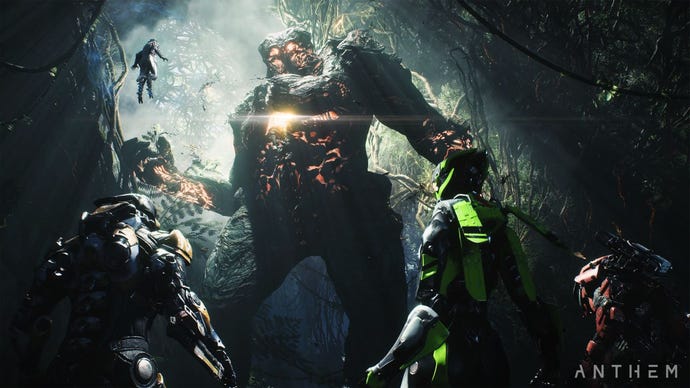If recent history is any indication, why should anyone trust EA to turn Anthem's fate around?
It’s hard to imagine EA righting Anthem’s ship when the publisher's consistently failed on live services.
EA has perhaps been one of the earliest proponents of the games-as-a-service trend. Though it took the publisher time to actually implement this strategy into its biggest games, it spent months touting it as a path forward in an age where one-and-done games may no longer be viable.
Which is what makes EA’s poor state of live service games all the more puzzling to anyone who’s been following its missteps this entire console generation.
Recently, after months of uncertainty, Battlefield 5 developer DICE made the game’s roadmap official, teasing some of the content coming to the WW2 shooter from now until the end of the year.
The hilariously anaemic schedule is full of non-committal statements and vague language that indicate those who put it together aren’t themselves certain about the game’s future. If there’s a sure-fire way to make existing players and potential customers lose faith in a game, this has to be it.
A few weeks later, BioWare announced it’s scrapping Anthem’s roadmap as it once again refocuses efforts on fixing the game’s core problems, now lingering months after release. These two examples don’t exist in a vacuum, and they're far from anomalies. The current state of either game isn’t a product of unforeseen circumstances.
In some ways, this goes back to Mass Effect: Andromeda, but the trend only started to earnestly take shape with Star Wars: Battlefront 2. Andromeda was never going to be the service game EA suits imagined it would be, but its multiplayer mode – at the very least – had a shot at being something players can return to for months after launch; something EA can continue to monetise.
That was certainly the publisher’s hope, and it could have generated enough recurring revenue to justify investment in content. But EA decided to instead cut its losses, leaving story threads unfinished for fans of the single-player, and abandoning whatever community formed around multiplayer.
EA dumped Andromeda and moved on. Later that year, Star Wars: Battlefront 2 released to a largely negative reception. Paid-for powerups were so ingrained into its core it took DICE months to retool it and come up with a halfway decent, albeit still flawed, progression system.
During these months of dormancy, Battlefront 2 received very little in the way of new content. Remember, Battlefront 2 was EA’s first big game to denounce season passes and welcome all players to what many naively assumed would be a similar cadence of content releases.
When the game eventually recovered, new content started rolling in, but even now, a year-and-a-half on, it's just now starting to catch up to the volume of content its predecessor received in 13 months. You could argue the setback brought on by the launch disaster is to blame, but that doesn’t really absolve the people making those poor decisions in the first place. EA was recovering from EA’s stumbles, after all – none of this is the result of outside factors.
It’s now come time for the same to happen to Battlefield 5, perhaps the best example of this pattern yet. Battlefield 5, too, was the first game, in a series traditionally reliant on season passes, to drop them in favour of paid cosmetics.
We were told EA and DICE had learned from their Battlefront 2 missteps, and so were ready for a new beginning; not just for Battlefield, but for EA’s image and apparent commitment to live services. Even as I write this, I can’t quite believe how far Battlefield has fallen from grace. The game is now six-months-old. So far, the only extra piece of fresh, meaningful content has been the Panzerstorm map.
I am not counting Firestorm, or the Combined Arms co-op mode simply because these were missing features, promised pre-release that only recently materialised. Extra here refers specifically to content we weren't told would be there on day one. More specifically, new locations, and new maps. In the game’s 2019 roadmap, DICE confirmed two maps would be released by June, which brings the total to three confirmed maps. That’s less than just the first expansion for Battlefield 1, Battlefield 4, or Battlefield 3.
New factions, which are being teased for the fall, would bring the total up to four in Battlefield 5 – if indeed DICE is teasing the Americans and Japanese. Battlefield 1 launched with six factions; Battlefield 4 with three, with Battlefield 3 the only equal at two.
And sure, Battlefield 5’s arsenal of weapons and vehicles have expanded since launch, but those were always considered the cherry on top of the various add-ons. Most of the excitement remains, as it’s always been, around new maps.
In every one of those examples, all three games released in less-than-ideal or downright broken states. Whether it was a lack of polish, or a game economy so busted it made lawmakers take note; each one of those launches created some controversy. Setting aside Andromeda for a moment, both Battlefront 2 and Battlefield 5 addressed their technical shortcomings in the months since, but it’s the content that’s going to keep players coming back, not fixes to launch day bugs.
The latest example of this clear pattern is Anthem. Anthem's start was rough – the roughest of all three, I’d argue. In fact, you can view the roadmaps for both Anthem, and Battlefield 5 as a clear sign EA really is following the same script.
Both roadmaps appear busy, but a closer look reveals how little substance they hold. Much of the promised content is not easy to pin down, especially in Anthem's case. I challenge anyone to come away with clear bullet points of what’s actually coming to that game in the next few months.
It would have been great for DICE to give an actual count of the maps it has in development, and their projected release targets. This still wouldn’t solve the game’s current drought, but one would at least find some solace in knowing that, say ten new maps are in the pipe.
It’s impossible for anyone looking at this recent history to have any confidence that Anthem won’t be a dead game by the end of this year. EA was happy to promise all future Anthem content for free, but the only way to revive the game at this point is not through some vapid live event, it’s likely going to take a Destiny: Taken King-style expansion specifically designed to address the base game’s shortcomings.
An expansion of that size takes a lot of time and investment, two things EA will undoubtedly charge players for when it comes time to hype up its release – if the series is not abandoned altogether.
Which brings me back to the most confusing aspect of EA’s output this entire generation. The situation EA finds itself in wasn’t caused by stiff competition, unforeseen changes in market trends, or cataclysmic events.
All of these wounds are self-inflicted, and the consistency with which they were can only be perceived as intentional. EA damaged its Battlefront brand – if not all of its Star Wars output, to the point it now has to paint its past self as a villain to sell fans on its latest Star Wars project.
It turned the once venerable Mass Effect into the butt of jokes, enough that making an “unmemeable game” was a serious concern for BioWare during Anthem’s development. Now, everyone watches as EA slowly suffocates its biggest shooter series. EA’s answer to Destiny; the first serious foray into the service games segment it has been so keen to break into, is lurching from controversy to disaster. How could anyone observing all that have any faith that Anthem won’t be forgotten like the rest?
Even beyond the scope of failures with each game, what does that mean for EA as a whole – what’s the endgame here? Will EA ever return to being a creative leader or forever languish as a licensing house?
I don’t have an answer to these questions, but I sure hope there’s a roadmap somewhere I can look at.












